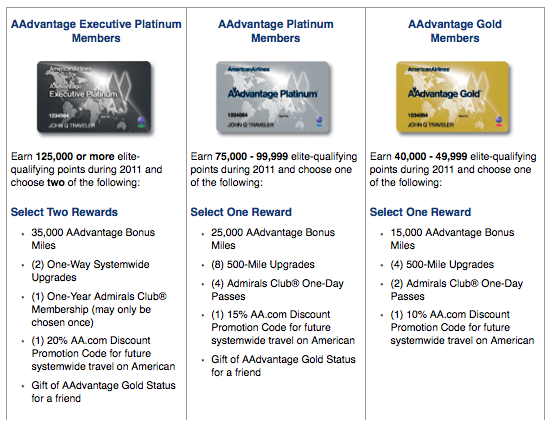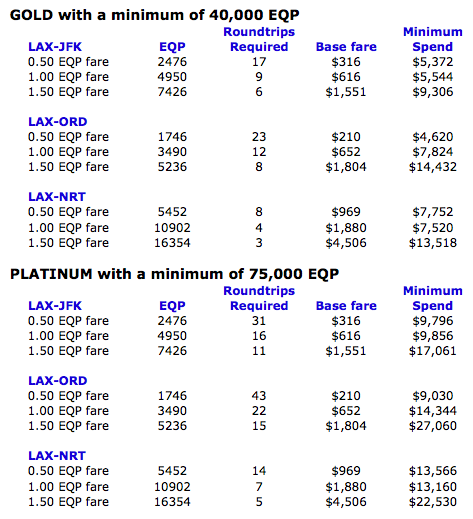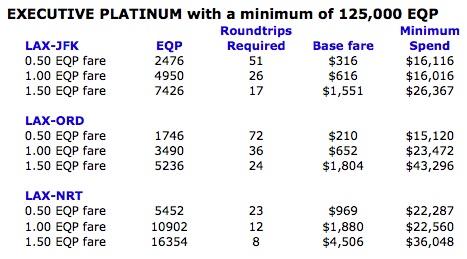Last week American Airlines launched elite rewards as part of the 30th anniversary of the AAdvantage frequent flyer program. It’s based on your elite status at the close of the year along with how many Elite Qualifying Points (EQPs) you’ve racked up to that point. Each tier has its own selection of rewards available once you pass the stated EQP requirement, which is summarized below.

Image courtesy American Airlines
Since I began flying American this year and will be Platinum at year-end, I was curious to see what type of spend would be necessary to qualify for the rewards. EQP accrual on American is determined by the amount of miles flown and the category of fare purchased. Deeply discounted economy fares, those I usually fly, only rack up 0.50 points per qualifying mile (those in G, Q, N, O and S buckets). I knew the spend would need to be a bit more significant and probably out of my budget as I’m still maintaining my top-tier status with United Airlines, but was hoping it might be achievable. I was eying the 25,000 bonus miles or gift of AAdvantage Gold status I could give to a friend.
So, I sampled a few fares and put together the following research into just how much it would cost to hit each threshold and confirmed it is way beyond my means. The good news, though, for business travelers paying higher fare classes is that this program will certainly add value to carrying elite status with American this year. Particularly if you’re Executive Platinum where you would get to pick two quite meaningful rewards in my opinion. The one-year Admirals Club membership is a fantastic bonus.
I sampled fares in three markets originating from Los Angeles: New York JFK, Chicago O’Hare and Tokyo. Each fare was the lowest currently available at the respective EQP level and didn’t include taxes, but I did add the hefty fuel surcharge into the Tokyo market fare ($670). In any case, you can see it would take about $5,000 to qualify for the rewards at the Gold level, $10,000 for Platinum and $15,000 for Executive Platinum. Yes this was a very small sampling only from LAX, but I think it paints the picture of just how much spend would be required.

 The revenue metric is indeed becoming much more prominent when rewarding the elite ranks of flyers. I think the days of full Elite Qualifying Miles (EQMs) for those low bucket fares are numbered, and airlines will focus on revenue as a determinant of elite status more heavily in the future. United’s rumored changes to Mileage Plus are in my opinion all but certain for the 2013 elite year, and while sad for me as a mileage runner, I’m fully supportive of the business rationality behind it.
The revenue metric is indeed becoming much more prominent when rewarding the elite ranks of flyers. I think the days of full Elite Qualifying Miles (EQMs) for those low bucket fares are numbered, and airlines will focus on revenue as a determinant of elite status more heavily in the future. United’s rumored changes to Mileage Plus are in my opinion all but certain for the 2013 elite year, and while sad for me as a mileage runner, I’m fully supportive of the business rationality behind it.


I understand the logic at the high-end too. But isn’t there a concern that this will make airline loyalty pointless for people who are 1-2 trips/yr travelers. Put differently, if I know that I don’t have a shot at making elite status because of my lack of spend, won’t I be more likely to look at other airlines?
Yes, absolutely the elite status by spend scenario (particularly United’s rumored changes) will cause some to just book the cheapest flights. We’ll see how that program eventually rolls out and it might drastically alter the buying behavior of the 1-2 trip people. Airlines need to keep in mind a little marketing 101: It’s harder to acquire a new customer than it is to retain one.
Darren said ‘United’s rumored changes to Mileage Plus are in my opinion all but certain for the 2013 elite year, and while sad for me as a mileage runner, I’m fully supportive of the business rationality behind it.’
I disagree. It’s comments like this, and the ones posted on Flyertalk that will encourage UA to make changes… since they think many are thinking that ‘oh well, this had to happen’.
Charlie Brown says GOOD GRIEF to that thinking.
dhammer
Dan,
While I understand your frustration to the changes, I have to side with the airlines in these cases. Total revenue is much more preferred to revenue only helping reduce bottom line loses. The true contributors to United’s profits are those who spend above the average CPASM, and I (and you, likely) are not one of them. We help them fill the incremental seats, but we are in no way profitable to them. Many bloggers disagree with me, but you can’t convince me that we add to their top-line goals of elite producers of revenue when we’re simply minimizing losses. Thanks for your comments, though… always good to get different viewpoints.